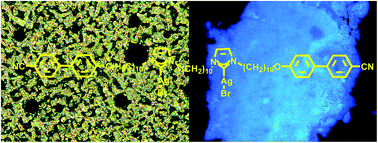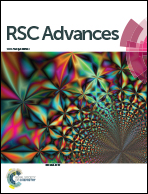Liquid crystals based on silver carbene complexes derived from dimeric bis(imidazolium) bromide salts†
Abstract
A series of bis(imidazolium) salts with different mesogenic groups (cyanobiphenyl or cholesteryl) and their silver carbene complexes with Br− anion has been designed and prepared. The liquid crystalline behaviour of these ionic liquids and their corresponding silver–carbene complexes was investigated by polarised optical microscopy (POM), differential scanning calorimetry (DSC) and powder X-ray diffraction while their thermal stability was studied by thermogravimetric analysis (TGA). The silver complexes are thermally stable on a broad temperature range with accessible transition temperatures close to ambient temperature. The compounds with cholesteryl groups show higher transition temperatures than the compounds possessing cyanobiphenyl mesogenic groups, but their thermal stability is limited by a slight decomposition before reaching the isotropic state. Interestingly, the bis(imidazolium) salt with two cyanobiphenyl groups at each side shows an enantiotropic nematic phase on a short range, being one of the few examples of ILC displaying nematic phase.


 Please wait while we load your content...
Please wait while we load your content...